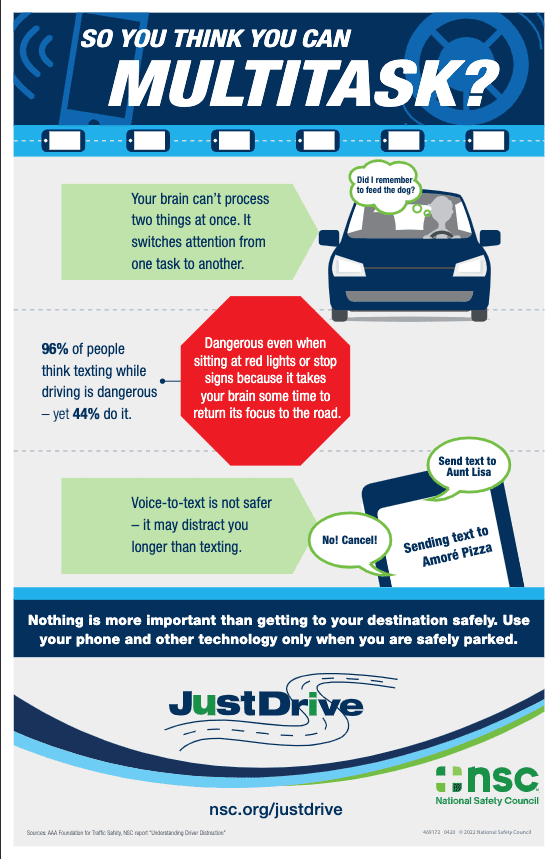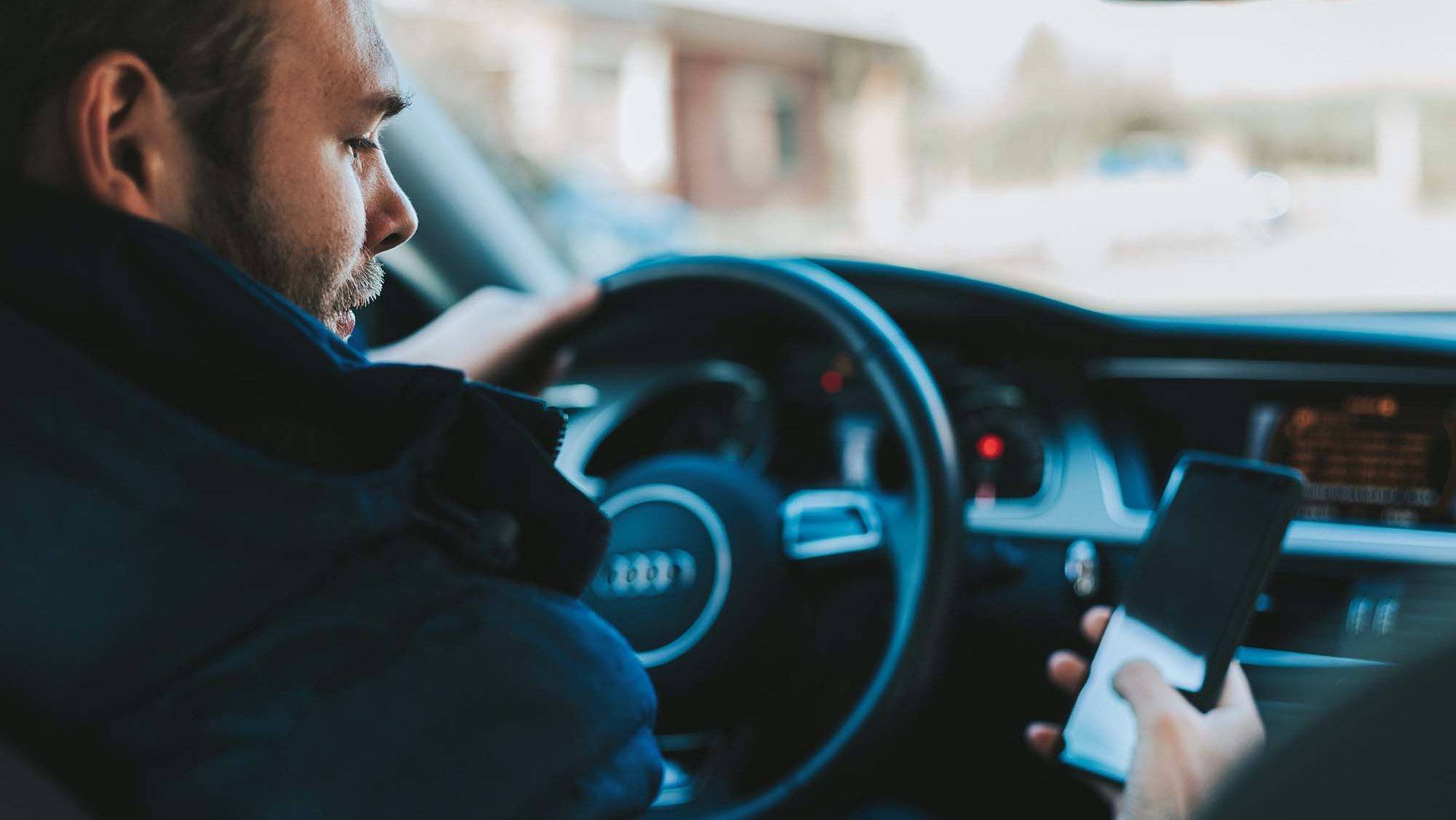In 2011, a distracted driving violation raised a driver’s car insurance rates by less than 16%, equating to less than $100 per year in extra premiums. In 2020, a cell phone violation can increase your insurance premiums by 21.38%.
Having traffic tickets, moving violations, and other infractions on your driving record can make it difficult to find affordable car insurance. Most drivers know that speeding tickets affect your insurance rates but many don't realize how much of a premium increase to expect.
From 2019 to 2020, the percent increase on your premium for a cellphone violation stayed the same at 22%, the trend leveling out from its upward climb since 2011. But the penalty for distracted driving has increased notably in recent years as insurers learn more about the costs and more states create laws prohibiting it.
In 2020, getting caught texting or otherwise using your phone while driving will raise your insurance rate by an average of 21.65% ($315) — and in some states more than 45.96%. The total cost to your insurance — the rate impact on your policy for three years — for a texting-while-driving violation is $1,772.
Many drivers simply believe they are better than everyone else on the road at multi-tasking while driving but the human brain cannot handle two thinking tasks at the same time. Your brain toggles quickly between multiple tasks but, when driving, this can slow reaction time and cause crashes.
Be safe by silencing your phone, programming your GPS, and setting up your music while you are still parked.
Sources:
https://www.thezebra.com/resources/research/distracted-driving-statistics/
https://www.thezebra.com/auto-insurance/tickets-violations/
https://www.thezebra.com/resources/research/texting-and-driving-statistics/
While the percentage of drivers using handheld devices has decreased in recent years, many experts feel the use of distracting devices is significantly undercounted.
Fact is, drivers frequently lose focus of the road. Their eyes drift and their minds wander as they connect on cell phones or other technologies built into vehicle dashboards.
So, let’s now talk about “inattention blindness,” defined as the failure to notice a visible hazard because your attention is focused elsewhere. This phenomenon occurs regularly when drivers are cognitively distracted.
Research shows just listening to a cell phone conversation decreases brain activity associated with driving by more than one-third, leading to safety performance issues, such as the inability to react quickly in congested driving zones.
Think of it as driving blindfolded. Who drives like that?
Of course, using electronics is not the only way drivers can be distracted. Talking or texting on the phone, eating or drinking, applying makeup or shaving, reading a newspaper or book, watching a video, or programming a GPS are all examples of the following distraction categories: visual, manual (taking a hand off the wheel) or cognitive (taking your mind off driving).
All can raise safety risks, not only for drivers but also for those sharing the road around them. Hands-free devices may be marginally safer than handheld ones, but the safest choice of all is not using your cell phone or other technology while you are driving.
Your brain toggles quickly between these two tasks. When driving, this can slow reaction time and cause crashes. Be safe by silencing your phone, programming your GPS and setting up your radio or music while you still are parked.
Your life is much more valuable than any phone call, text or playlist.
Sources:
nsc.org/justdrive
https://newsroom.aaa.com/2017/10/new-vehicle-infotainment-systems-create-increased-distractions-behind-wheel
https://injuryfacts.nsc.org/motor-vehicle/motor-vehicle-safety-issues/distracted-driving
https://www.cmu.edu/news/archive/2008/March/march5_drivingwhilelistening.shtml

Hands-free is not risk free.
The science is crystal clear on this fact and numerous studies have demonstrated that the use of handheld and hands-free devices while driving pose a significant safety risk to motorists, their passengers and others on the road.
Hands-free devices and voice command systems create a cognitive distraction as the driver mentally engages with interactive tasks.
While hands-free options may be marginally safer than handheld devices, eliminating driver use of all types of cell phones and in-vehicle infotainment systems is safest.
Drivers think cell phone use is distracting … for other people
Although 87% of people think talking on a cell phone while driving is a serious safety threat, 49% have talked on a handheld phone while driving. Drivers should talk the talk AND walk the walk, refraining from using their phone when behind the wheel.
It is impossible to multitask and give equal attention to each task
People often think they are effectively accomplishing two tasks at the same time. It is possible to complete a phone conversation while driving and arrive at the destination without incident, but it is a misconception that the tasks can be done simultaneously and as safely as possible. Motorists should make driving the primary focus and perform other cognitively demanding tasks only when safely parked.
Source: nsc.org/justdrive
“Traffic crashes are the leading cause of death for teen drivers and knowing that a whopping majority of teens admit to driving distracted is very scary,” says Marie Dodds, AAA Oregon/Idaho Director of Government and Public Affairs. Texting while driving is among the riskiest of common driving distractions. Teen drivers are still developing safe driving skills and should limit unnecessary risks.
Texting while driving is among the riskiest of common driving distractions. Despite texting bans in 48 states, smartphone use behind the wheel is a common problem. Research released by the AAA Foundation for Traffic Safety finds that even though 96 percent of drivers say texting/emailing while driving is a serious or very serious threat to their safety, 39 percent admit to having read a text or email, and 29 percent admit to typing one.
If you have been injured in an auto accident in or around Dallas, contact Stanley & Associates for your free case consultation. Stanley & Associates has represented clients across Texas and throughout the United States for over ten years. Our firm has successfully won thousands of cases during this time.
Our Dallas car accident attorneys are available 24/7 to assist you. We work on a contingency fee basis, which means no fee unless we win. Call 844-227-9739
A Travelers survey of over 1,000 consumers and business managers reveals that the pandemic has lulled people into a false sense of road security.
“Traffic volumes were lower during the early days of the pandemic, which may have given drivers a false sense of security. Not only did distracted driving increase, data from our telematics product IntelliDrive shows that speeding also became more prevalent. As travel restrictions are lifted around the country, it’s critical to slow down and stay focused on the road by eliminating distractions.”
Chris Hayes, Second Vice President of Workers Compensation and Transportation, Risk Control, at Travelers
One in four drivers think that roads are safer today than they were before a pandemic, and a growing number of respondents reported using their phones in unsafe ways while driving, including:
Despite the decrease in traffic, approximately 13% more people died on U.S. roads in the second half of 2020 compared to the same time the year prior, according to the National Highway Traffic Safety Administration (NHTSA). A new study from AAA found an increase in reckless drivers on the roads may be to blame.
The study, conducted in fall of 2020, found an estimated 4% of drivers in the United States reported they increased their driving during the pandemic. Those drivers tended to be younger and mostly male, AAA said. That group also reported to engage in risky driving behaviors such as distracted driving, speeding, aggressive driving, substance-impaired driving and not using seatbelts, the report found.
If you or a loved one have been injured in a car wreck due to a drunk driver, contact Stanley & Associates for your free case consultation. We have represented thousands of clients across Texas and have over a decade of experience.
Our Texas car accident attorneys are available 24/7 to assist you. We work on a contingency fee basis, which means no fee unless we win. Call 844-227-9739

Back in 2010, Congress passed a resolution to create a special month devoted to increasing awareness of the dangers of distracted driving. According to a survey conducted by National Occupant Protection Use Survey, approximately 660,000 drivers are using cell phones or manipulating electronic devices at any given moment.
"Distracted driving is a serious and deadly epidemic on America’s roadways,” said U.S. Transportation Secretary Ray LaHood. “There is no way to text and drive safely. Powering down your cell phone when you’re behind the wheel can save lives – maybe even your own.”Being an attentive and alert driver can help prevent crashes that lead to unintentional injury and death.
With the rapid adoption of smartphones in the United States, distracted driving has become a hot topic in traffic safety. While cell phones and navigation devices often are the culprit when it comes to distracted driving, conventional distractions such as interacting with passengers and eating also contribute to crashes. Distracting tasks can affect drivers in different ways and can be categorized as visual, manual, and cognitive distraction.
Make no mistake, multitasking technology is about convenience - not safety. Ending distracted driving is everyone's responsibility.
If you have been injured in an auto accident in or around Dallas, contact Stanley & Associates for your free case consultation. Stanley & Associates has represented clients across Texas and throughout the United States for over ten years. Our firm has successfully won thousands of cases during this time.
Our Dallas car accident attorneys are available 24/7 to assist you. We work on a contingency fee basis, which means no fee unless we win. Call 844-227-9739